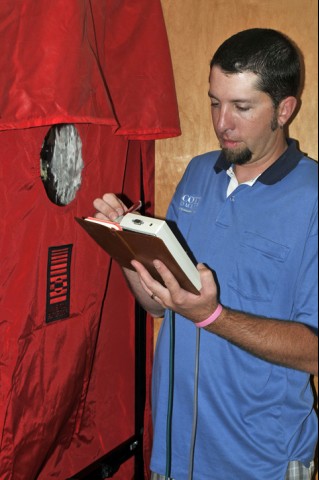Do-It-Yourself Survey
Autumn officially brings on the signs of the heating season, and with it comes cooler weather and fewer hours of daylight. Fall is a great time to start thinking of a home energy assessment so that you can prepare your home for winter, saving energy and money in the process.
Summer knocks on the door and brings the signs of warmer weather and the use of Air Conditioning and ventilation into the picture. Whether it is fall, winter, spring or summer time, energy usage is a year round event. There is no time like the present to start to understand how you can save money on your utility bills on a monthly basis. Who knows you might just save enough to pay for a nice vacation?
The main purpose of an energy assessment is to determine whether your home wastes energy, and to pinpoint where energy is being lost so you can evaluate what measures you can take to make your home more energy efficient. Assessments also determine the efficiency of your home’s heating and cooling systems, and ways to conserve hot water. Audits can be as simple as a do-it-yourself survey, a complete BPI Assessment, or they can be very detailed, using specific tools and techniques to pinpoint air leaks and ultimately rate your house against others.
If you've lived in your home for some time, you already may be familiar with areas that get drafty as the cold, wintry weather approaches or hot and stuffy as summer shines on us. Sky-high energy bills may hint at the inefficiency of your appliances, heating and cooling equipment.
A do-it-yourself energy survey, commonly referred to as a walk-through, is the simplest and most common method of conducting an energy audit. Go room-by-room to check for air leaks. There are many potential sites for air to leak into or out of your home, including: windows and doors, gaps around pipe and wire feed through’s, electrical outlets, foundation seals, mail slots, exhaust fans, attics, attic access points, garage doors, siding cracks, and old caulking. Check insulation levels where possible. Look at the age of your heating and cooling equipment, and past maintenance records and maintenance schedules; check to see if filters are clean. Review the types of lighting in your home, and explore more efficient alternatives. Be sure to keep a checklist of areas you inspected and problems you found. This list will help you prioritize your energy efficiency upgrades.
If you’re somewhat computer savvy, you may be interested in using a computer program to conduct a more thorough energy audit. Home Energy Saver , the Federal Energy Management Check List and the ACEEE are a few free web-based do-it-yourself residential energy audit tools. These tools can help you determine the savings you can expect from making specific energy upgrades, and thus help you prioritize improvements to make. Or try the ENERGY STAR® Home Energy Yardstick to compare your home's energy efficiency to similar homes across the country and get recommendations for energy-saving home improvements from ENERGY STAR.
The Aliance to Save Energy has a check up program as well.
Another option is to have Colorado Energy Analysts come in to conduct a sophisticated energy assessment on your home. Our Certified "house doctors" use tools such as blower doors, infrared cameras, digital surface thermometers, and smoke pencils to detect leaks in the building’s envelope—your home’s surface area exposed to the outside.
We may conduct a building depressurization test that measures the leakiness of the building envelope, and a thermographic inspection that reveals the often hard-to-detect areas of infiltration and areas where insulation is missing. These "house doctors" will generate a report with the results of their tests. This report typically includes a list of where you are wasting energy, what improvements you can make, estimates on what these improvements will cost, and what your annual savings will be should you make the recommended improvements. In some cases, the house doctors will carry out some energy-conserving measures on site at the time of the audit. Ask beforehand to find out which of these services the company provides and what the fees are. These professional tests tend to be expensive, but the savings after upgrades can be considerable.
Where can you locate professional energy audit companies? Your first step should be to contact Colorado Energy Analysts ot you may try your local electric or gas utility to see if they offer free or discounted energy audits to their customers. Your local city or county government or the Colorado Governors Energy Office may help you identify a local company or organization that performs audits. They may also have information on how to do your own audit. Low-income residents should contact their weatherization office.
Two other good resources that can help locate a professional energy audit company near you are Home Performance with ENERGY STAR and Residential Energy Services Network. If you’re planning to make extensive energy improvements, you may wish to think about having us perform an energy rating for your home with the energy audit, and then applying for an energy efficient mortgage, EEM. An Energy Improvement Mortgage finances the energy upgrades of your existing home in the mortgage loan using monthly energy savings.
At Colorado Energy Analysts, we can help you with this process. Please contact us today to start your path to monthly energy bill savings. We have a Home Energy Survey that starts at $99.
Jon Howes
Professionally Certified

BPI Certified Building Analysts
RESNET Certified HERS Rater
RRP - Certified Lead Paint Renovator
Colorado Energy Analysts
Certified Energy Rater
Scott Homes, Ltd., Designers & Builders
Construction Superintendent
 |
 |
 |
Schedule An Inspection
By Phone or Email we can schedule the services you desire to begin saving money on your utility bills!
Contact Us Online
Email us at info@ColoradoEnergyAnalysts.com
© Copyright 2013-2024 - Colorado Buys Local Inc | Designed for Colorado Energy Analysts